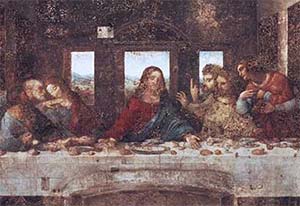The Last Supper
Charles Dickens reports on the current state of the Leonardo da Vinci masterpiece
Charles Dickens - Condensed from Pictures from Italy (1846)

The Last Supper by Leonardo da Vinci
In the old refectory of the dilapidated Convent of Santa Maria delle Grazie, is the work of art, perhaps, better known than any other in the world: the Last Supper, by Leonardo da Vinci--with a door cut through it by the intelligent Dominican friars, to facilitate their operations at dinner-time.
I am not mechanically acquainted with the art of painting, and have no other means of judging of a picture than as I see it resembling and refining upon nature, and presenting graceful combinations of forms and colours. I am, therefore, no authority whatever, in reference to the 'touch' of this or that master; though I know very well (as anybody may, who chooses to think about the matter) that few very great masters can possibly have painted, in the compass of their lives, one-half of the pictures that bear their names, and that are recognised by many aspirants to a reputation for taste, as undoubted originals. But this, by the way. Of the Last Supper, I would simply observe, that in its beautiful composition and arrangement, there it is, at Milan, a wonderful picture; and that, in its original colouring, or in its original expression of any single face or feature, there it is not. Apart from the damage it has sustained from damp, decay, or neglect, it has been (as Barry shows) so retouched upon, and repainted, and that so clumsily, that many of the heads are, now, positive deformities, with patches of paint and plaster sticking upon them like wens, and utterly distorting the expression. Where the original artist set that impress of his genius on a face, which, almost in a line or touch, separated him from meaner painters and made him what he was, succeeding bunglers, filling up, or painting across seams and cracks, have been quite unable to imitate his hand; and putting in some scowls, or frowns, or wrinkles, of their own, have blotched and spoiled the work. This is so well established as an historical fact, that I should not repeat it, at the risk of being tedious, but for having observed an English gentleman before the picture, who was at great pains to fall into what I may describe as mild convulsions, at certain minute details of expression which are not left in it. Whereas, it would be comfortable and rational for travellers and critics to arrive at a general understanding that it cannot fail to have been a work of extraordinary merit, once: when, with so few of its original beauties remaining, the grandeur of the general design is yet sufficient to sustain it, as a piece replete with interest and dignity (American Notes-Pictures from Italy, p. 346).
Back to the Reading Charles Dickens page
 Copyright © 1997-
David A. Perdue, All Rights Reserved.
Copyright © 1997-
David A. Perdue, All Rights Reserved.